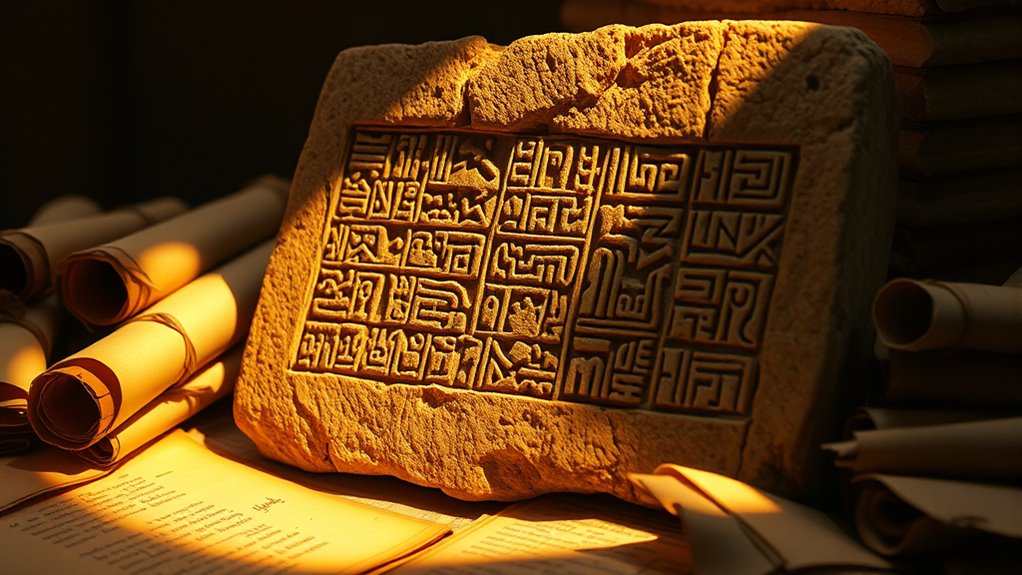The 70 weeks of Daniel is a biblical prophecy that covers key events in history, including the rebuilding of Jerusalem, the coming of the Messiah, and ultimate redemption. It’s divided into three parts: the first 7 weeks, 62 weeks, and the final week, with significant moments at each stage. This prophecy reveals God’s precise plan for history and His promises. To understand how these timelines connect, keep exploring the details behind this powerful vision.
Key Takeaways
- The 70 Weeks of Daniel is a prophetic timeline divided into three phases: 7 weeks, 62 weeks, and 1 final week.
- It predicts key events such as the rebuilding of Jerusalem, the arrival of the Messiah, and the final judgment.
- The prophecy symbolizes God’s divine plan for history, culminating in redemption and spiritual victory.
- Interpretations vary between literal, symbolic, and futurist views, sparking ongoing scholarly debate.
- The prophecy underscores God’s sovereignty and precise orchestration of historical and future divine events.
Historical Context of Daniel’s Prophecy

To understand Daniel’s prophecy, it’s essential to grasp the historical context in which it was written. During this period, the Jewish people faced exile and upheaval under Babylonian and Persian rule, shaping their worldview and hopes for future restoration. The prophecy reflects a desire for divine intervention and future redemption, influenced by cultural beliefs and religious traditions of the time. The text emphasizes historical accuracy by referencing specific nations and rulers, grounding its messages in real-world events. These cultural influences help explain the vivid imagery and symbolic language used, as Daniel’s visions aimed to reassure the Jewish community amid uncertainty. Recognizing this context allows you to better appreciate the prophecy’s significance and the way it connected past experiences with future promises.
Breakdown of the 70 Weeks Timeline

The 70 weeks timeline in Daniel’s prophecy is a detailed plan that outlines specific periods of divine intervention and fulfillment. It employs apocalyptic symbolism to convey complex events with vivid imagery, emphasizing the prophetic precision behind each segment. The breakdown reveals three key phases: the initial seven weeks, which mark the rebuilding of Jerusalem, followed by sixty-two weeks leading up to a significant messianic event. The final week signifies a pivotal moment of judgment and redemption. Understanding this breakdown helps you see how the timeline fits into God’s divine plan, illustrating both the historical and future fulfillments. The prophecy’s precision underscores that these periods aren’t arbitrary but divinely orchestrated, revealing God’s sovereignty over history and His ultimate plan for salvation.
The Significance of the First Seven Weeks

The first seven weeks of Daniel’s prophecy mark a pivotal beginning, emphasizing the rebuilding of Jerusalem after a period of turmoil. This initial period holds great chronological significance, anchoring the entire 70-week timeline. It sets the stage for understanding key eschatology debates about prophetic precision and fulfillment. Recognizing this timeframe helps clarify how biblical history aligns with prophetic promises, especially regarding the restoration of Jerusalem. The table below highlights this importance:
| Period | Key Event | Significance |
|---|---|---|
| First Seven Weeks | Rebuilding Jerusalem | Marks the start of prophetic timeline |
| Middle of the 70 Weeks | Unknown (next topic) | Critical for understanding messianic events |
| Final Weeks | Future fulfillment | Eschatological culmination |
This shows how foundational the first seven weeks are for decoding the entire prophecy.
The Middle of the Seventieth Week: Key Events

At the midpoint of the seventieth week, significant events unfold that are essential for understanding biblical prophecy and its fulfillment. This moment marks a critical point in eschatological symbolism, where prophetic fulfillment reaches a climax. You see, the temple’s desecration and the rise of the antichrist symbolize the culmination of spiritual opposition against God’s plan. These key events serve as a turning point, revealing the depth of prophetic layers and their connection to future events. The symbolism highlights a period of intense conflict and deception, confirming that God’s timeline is unfolding precisely as foretold. Recognizing this midpoint helps you grasp the unfolding of divine prophecy, emphasizing how each event aligns with the broader picture of biblical eschatology.
Messianic Implications of the Prophecy

As you examine the prophetic timeline of the seventieth week, the messianic implications become strikingly clear, revealing that these events point directly to the fulfillment of God’s promise through Jesus Christ. The prophecy aligns perfectly with Messianic expectations, confirming that the Messiah would arrive at a specific time to fulfill God’s plan for salvation. The cutting off of the Messiah, as foretold, signifies His sacrificial death, fulfilling prophetic fulfillment foretold centuries earlier. These details demonstrate that the 70 weeks are not just a timeline of historical events but a divine blueprint leading to Christ’s atoning work. Recognizing this connection deepens your understanding of how God’s promises are intricately woven into history, culminating in the Messianic fulfillment in Jesus.
Symbolic vs. Literal Interpretations

Understanding the prophetic timeline of the seventieth week invites you to contemplate how it can be interpreted in different ways—either symbolically or literally. Some see apocalyptic symbolism as representing broader spiritual truths, using allegorical meaning to illustrate divine plans. This approach emphasizes figurative language, viewing the events as symbolic of cosmic battles or spiritual realities rather than specific dates. Conversely, a literal interpretation grounds the prophecy in actual historical timelines, expecting precise fulfillment of weeks and events. Both perspectives have their strengths: symbolism allows for deeper spiritual insights, while literalism seeks concrete fulfillment. Recognizing these differences helps you appreciate the complexity of biblical prophecy and the ways interpretive lens shape your understanding of God’s timeline.
How Different Traditions View the 70 Weeks

Different traditions interpret the 70 weeks in various ways, with some seeing it as a literal timeline and others viewing it symbolically. You’ll notice that prophetic timelines also differ, shaping how each group understands the prophecy’s fulfillment. Exploring these perspectives helps clarify how history and theology influence their views.
Literal vs. Symbolic Interpretations
The interpretation of the 70 Weeks prophecy varies markedly across religious traditions, with some viewing it as a literal timeline and others seeing it as symbolic. Those favoring a literal approach often focus on specific dates and events, emphasizing eschatological symbolism rooted in prophecy. Conversely, symbolic interpretations interpret the weeks as representing broader historical allegories rather than precise periods. This perspective allows for flexible understanding of the prophecy’s message within a spiritual or theological context. Key differences include:
- Literalists see the weeks as exact timeframes tied to historical events.
- Symbolists interpret the weeks as allegories for spiritual or divine processes.
- Both views aim to uncover divine truths, but differ in methodological approach.
- The symbolic view often emphasizes eschatological symbolism over strict chronology.
This divergence influences how you understand the prophecy’s relevance today.
Prophetic Timelines Across Traditions
Across various religious traditions, the 70 Weeks prophecy is interpreted through distinct timelines that reflect their theological perspectives. You’ll find that some view it as a literal countdown to specific events, emphasizing prophetic numerology to determine precise dates. Others see it as symbolic, representing larger periods of divine intervention using apocalyptic symbolism. For example, Jewish interpretations often focus on the messianic era, interpreting the weeks as symbolic chunks of time leading to redemption. Christian traditions may see the 70 Weeks as a forecast of Christ’s ministry and second coming, blending apocalyptic symbolism with prophetic numerology. These differing approaches shape how each tradition understands the prophecy’s timeline—whether as a literal sequence or a symbolic framework conveying divine purpose across history.
Contemporary Perspectives and Debates

Why do contemporary scholars continue to debate the meaning of Daniel’s 70 weeks? It’s because they grapple with interpreting apocalyptic symbolism and identifying prophetic fulfillment. Different perspectives emerge from varied approaches, including literal and symbolic readings. Some see the 70 weeks as a precise timeline, while others view it as a metaphorical framework representing divine plans. Debates often focus on:
- The historical context versus future fulfillment
- The significance of specific dates and events
- The symbolic meaning of “weeks” in prophetic language
- The relationship between Daniel’s visions and other apocalyptic texts
These discussions reflect ongoing efforts to reconcile biblical prophecy with historical and theological understanding, keeping the debate vibrant and dynamic. Your exploration reveals how interpretations evolve within contemporary scholarship.
Frequently Asked Questions
How Does the 70 Weeks Prophecy Relate to End-Times Theology?
You see, the 70 weeks prophecy connects to end-times theology through its eschatological symbolism and prophetic fulfillment. It outlines a timeline that points toward significant future events, like the return of Christ and final judgment. By understanding these symbols and fulfilled prophecies, you can better grasp how biblical prophecy guides your view of the end times, emphasizing God’s ultimate plan and the hope of divine intervention in history’s conclusion.
What Historical Events Are Debated as Fulfilling the Prophecy?
Did you know that over a dozen major events are debated as fulfilling this prophecy? You might consider the rise of Messianic expectation around 4 BCE or the reconstruction of the Temple in the first century. These historical moments align with key markers in the prophecy, sparking debates among scholars about their significance. The timing of these events influences how people interpret the fulfillment of biblical prophecy and its link to end-times theology.
Are There Any Archaeological Findings Supporting the Prophecy’S Timeline?
You wonder if archaeological evidence and dating methods support the prophecy’s timeline. While some discoveries, like inscriptions and artifacts, align with biblical dates, definitive proof remains elusive. Dating methods such as radiocarbon or pottery analysis provide approximate timelines, but no conclusive archaeological evidence directly confirms the prophecy’s specific timeline. Consequently, ongoing excavations and advancements in dating techniques continue to shape the discussion, yet certainty remains out of reach.
How Do Non-Christian Religions Interpret the 70 Weeks?
Did you know over 2.3 billion people follow non-Christian religions? In religious interpretations, many see prophetic symbolism in various texts, but the 70 weeks are often viewed differently. For example, Jewish scholars interpret it as a timeline for events in their history, while some Muslim scholars see it as symbolic of divine plans. These diverse perspectives highlight how different faiths interpret prophetic symbolism without aligning with Christian views.
What Is the Prophecy’S Relevance to Modern Geopolitics?
You might see prophecy implications influencing modern geopolitics, as leaders sometimes interpret ancient predictions to guide decisions. These beliefs can shape diplomatic strategies, fostering alliances or tensions based on perceived divine plans. While not everyone subscribes, understanding these perspectives helps you grasp how religious prophecies impact political discourse today, highlighting the enduring power of prophecy implications in shaping the complexities of modern diplomacy and international relations.
Conclusion
Understanding the 70 weeks of Daniel unlocks a treasure trove of prophetic insight that’s as profound as uncovering the universe’s deepest mysteries. By grasping its timeline and significance, you gain clarity on divine plans woven through history. Whether you see it symbolically or literally, this prophecy’s impact is monumental, shaping perspectives across ages. Embrace this knowledge boldly—you’re on the brink of discovering a truth so powerful, it could alter your entire worldview forever.










